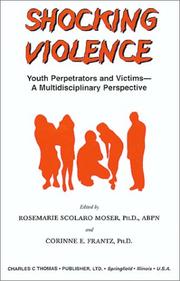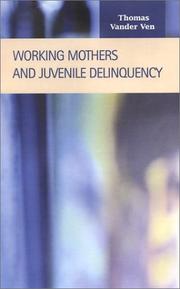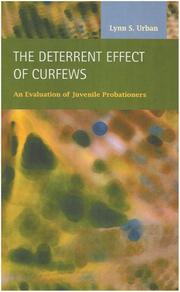| Listing 1 - 10 of 644 | << page >> |
Sort by
|
Book
Year: 2017 Publisher: London (UK) : Howard League for Penal Reform,
Abstract | Keywords | Export | Availability | Bookmark
 Loading...
Loading...Choose an application
- Reference Manager
- EndNote
- RefWorks (Direct export to RefWorks)
The pernicious and damaging effects of incarcerating juveniles has long been a topic of concern and controversy for reform groups, policy makers, childcare practitioners and academics; such concerns are doubly compounded where the mental health needs of the confined young person are in question. Yet, while there is a considerable scholarly literature on the history of juvenile delinquency and juvenile justice systems more broadly, there have been few substantial treatments of the institutional detention of juveniles in the modern era outside of official and non-official inquiries into historical allegations of child abuse. Equally, aside from a small number of highly focused studies, there is a paucity of scholarly research on the history of the mental health of juveniles in secure settings. Here, I detail the change in our understanding of the juvenile offender from that of a degraded if redeemable moral agent in the nineteenth century to our current conception of the detained youth as a figure marked by psychiatric morbidity, behavioural disturbance and complex needs. One of my central findings is that the context of institutional confinement itself has been an essential factor in the long-term psychiatric pathologisation of detained juveniles. This framed the scale, manner and context of their frequent group conceptualisation as potentially dangerous and uniquely debilitated by psychiatric morbidity. This is not to argue that the presence of trauma and psychiatric morbidity amongst juveniles in custody is simply a historical construct. Nor is it an argument that the use of psychiatry for detained youths merely constituted yet another instance of factitious medical labeling for the purposes of social control. Rather I suggest that, historically at least, the deployment of psychiatric diagnoses and treatment facilities within the youth secure estate has often primarily served institutional or political needs rather than the needs of juveniles in custody.
Book
ISBN: 1593325754 9781593325756 9781593323219 1593323212 Year: 2009 Publisher: El Paso LFB Scholarly Pub. LLC
Abstract | Keywords | Export | Availability | Bookmark
 Loading...
Loading...Choose an application
- Reference Manager
- EndNote
- RefWorks (Direct export to RefWorks)
In 1993 Terrie Moffitt offered a developmental taxonomy of delinquency that proposed three distinct types of juveniles: Life-course-persistent offenders, Adolescence-limited offenders, and Abstainers. Saunders tests both Moffittâ€TMs theory and the modeling methodologies and statistical software that have been used to test it. Saunders finds that group-based trajectory modeling technique is insufficient in capturing the hypothetical subpopulations specified by Moffittâ€TMs theory. Findings were mixed with respect to Moffittâ€TMs hypotheses about the development of delinquency and its causes and c
Book
ISBN: 161324469X Year: 2009 Publisher: New York : Nova Science Publishers,
Abstract | Keywords | Export | Availability | Bookmark
 Loading...
Loading...Choose an application
- Reference Manager
- EndNote
- RefWorks (Direct export to RefWorks)
Juvenile delinquency. --- Juvenile delinquency --- Prevention.

ISBN: 0398083223 9780398083229 0398071209 9780398071202 0398071217 9780398071219 Year: 2000 Publisher: Springfield, Ill. Charles C Thomas
Abstract | Keywords | Export | Availability | Bookmark
 Loading...
Loading...Choose an application
- Reference Manager
- EndNote
- RefWorks (Direct export to RefWorks)
Shocking Violence: Youth Perpetrators and Victims, A Multidisciplinary Perspective is written by contributors in the diverse fields of psychology, social work, educations, law enforcement, ministry, and the judicial system. The chapters cover the topic of youth violence with emphasis on recommendations for educators, parents, and treatment professionals to help children at risk. Many factors that contribute to youth violence are explored including an examination of personality development by Corrine Frantz and Rosemarie Scolaro Moser, who cite the incidents at Pearl, Mississippi, Jonesboro, Ar

ISBN: 1593320809 9781593320805 9781931202725 1931202729 Year: 2003 Publisher: New York LFB Scholarly Pub.
Abstract | Keywords | Export | Availability | Bookmark
 Loading...
Loading...Choose an application
- Reference Manager
- EndNote
- RefWorks (Direct export to RefWorks)
Book
ISBN: 0398091080 9780398091088 9780398091071 Year: 2016 Publisher: Springfield, Illinois
Abstract | Keywords | Export | Availability | Bookmark
 Loading...
Loading...Choose an application
- Reference Manager
- EndNote
- RefWorks (Direct export to RefWorks)
Book
ISBN: 9461660480 9789461660480 9789058678270 Year: 2010 Publisher: Leuven Universitaire Pers Leuven
Abstract | Keywords | Export | Availability | Bookmark
 Loading...
Loading...Choose an application
- Reference Manager
- EndNote
- RefWorks (Direct export to RefWorks)
In legal youth is an increasing number of claims and remedies imposed to score in both cases concerning problematic educational situation (POS) and juvenile delinquency (MOF) in recent years. This increase is partly the result of a growing influx of minors. In addition, the decisions of public prosecutors and juvenile judges in the various stages of the judicial process is of great importance.
Book
Abstract | Keywords | Export | Availability | Bookmark
 Loading...
Loading...Choose an application
- Reference Manager
- EndNote
- RefWorks (Direct export to RefWorks)

ISBN: 1593323174 9781593323172 9781593322137 1593322135 Year: 2007 Publisher: New York : LFB Scholarly Pub.,
Abstract | Keywords | Export | Availability | Bookmark
 Loading...
Loading...Choose an application
- Reference Manager
- EndNote
- RefWorks (Direct export to RefWorks)
Book
ISBN: 1612097308 9781612097305 9781606922866 1606922866 Year: 2009 Publisher: New York Nova Science
Abstract | Keywords | Export | Availability | Bookmark
 Loading...
Loading...Choose an application
- Reference Manager
- EndNote
- RefWorks (Direct export to RefWorks)
| Listing 1 - 10 of 644 | << page >> |
Sort by
|

 Search
Search Feedback
Feedback About UniCat
About UniCat  Help
Help News
News